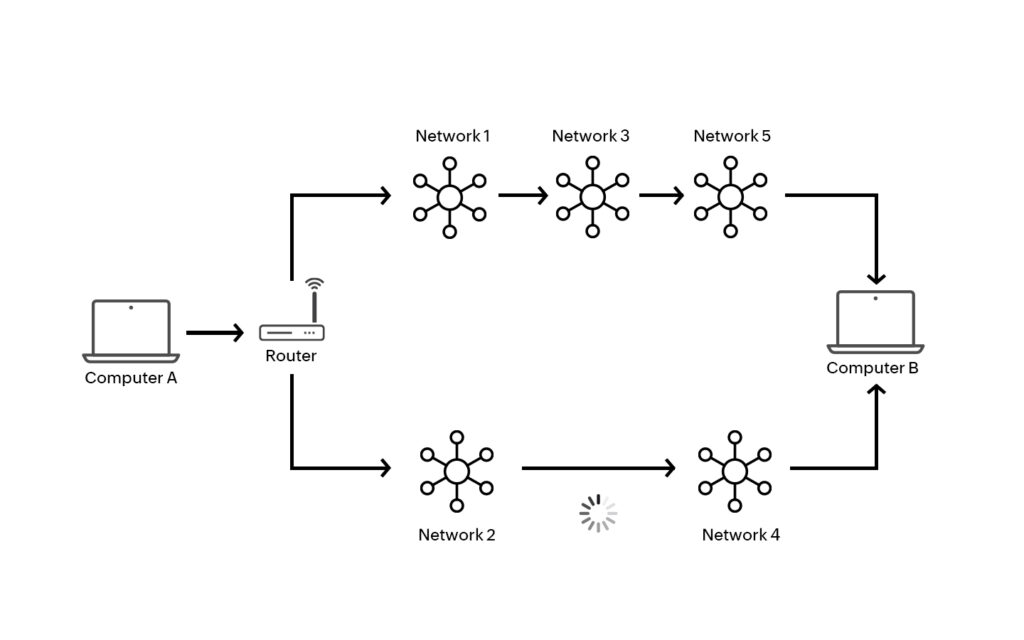If you’ve ever tried to browse the internet or set up a home network, you’ve probably come across the concept of routing. In the realm of networking, routing is one of the most fundamental processes, and while it may sound complex, it’s essential to understand how devices communicate with each other within a network. In this article, I will guide you through the key concepts of how routing works, broken down into simple and comprehensible terms.

What is Routing in Networks?
Routing is the process through which data packets travel across a network from their source to their destination. Imagine sending a letter from your house to a friend’s. To ensure it arrives correctly, the mail carrier needs to follow a series of steps, taking different routes and paths to reach its destination. In the digital world, “data packets” are sent through “routes” and guided by devices called routers.
A router is a network device that determines the best path for data packets. Think of it as an intermediary between different networks, evaluating and deciding the most efficient route for data packets based on various factors such as network traffic and route availability.
The Role of Routers in a Network
Routers are crucial for packet routing because they maintain a database called a routing table. This table stores all possible routes to send packets to their destination. As packets travel, routers read the address information contained in the packet headers and decide the next hop toward their final destination. This process repeats until the data reaches the recipient.
Routers can operate at different levels depending on the type of network and configuration. In a home network, the router typically connects the local network (like your Wi-Fi network) to the external network (the internet). In larger networks, such as corporate networks or the internet itself, routers can be far more complex, operating between different Internet Service Providers (ISPs) and ensuring data travels through the most efficient network paths.
How Are Routing Decisions Made?
When a router receives a packet, it first reads the destination IP address of the packet to determine which network it belongs to. Then, it consults its routing table to find the best path. Several algorithms are used by routers to make these decisions, based on factors such as:
Distance: Some routers use “distance vector” algorithms that determine the best route based on the number of hops a packet must take before reaching its destination.
Bandwidth: Other algorithms prioritize routes with higher bandwidth capacity to avoid congestion and ensure faster transmission.
Latency: In some cases, latency (the delay in transmission time) is also an important factor when choosing a route.
Routers in larger networks can use more complex algorithms, such as OSPF (Open Shortest Path First) or BGP (Border Gateway Protocol), to determine routes dynamically, considering factors like the current state of the network, routing policy, and route reliability.
Types of Routing
Static Routing
In static routing, the network administrator manually configures routes in the routers. This type of routing is suitable for small networks or environments where routes don’t change frequently. Although relatively straightforward, static routing can become problematic if the network topology changes, as any modification requires manual intervention.
Dynamic Routing
On the other hand, dynamic routing allows routers to exchange route information with each other and automatically adjust their routing tables. This type of routing is far more flexible and suitable for large, complex networks where routes can frequently change due to traffic fluctuations or link failures.
Dynamic routing protocols such as RIP (Routing Information Protocol), OSPF, and BGP enable routers to communicate with one another to share route information and make real-time routing decisions. This makes networks far more adaptable and resilient to unforeseen changes.
Common Routing Protocols
Several routing protocols allow routers to exchange information about available routes. These protocols are divided into two main categories: Internal Gateway Protocols (IGPs) and External Gateway Protocols (EGPs).
Internal Gateway Protocols (IGP)
These protocols are used within a single network or autonomous system (AS). They manage how data is distributed within the local network. Some of the most popular ones include:
RIP (Routing Information Protocol): RIP is one of the oldest and simplest protocols. It uses the concept of “hops” to determine the best route. In this protocol, each router periodically sends its routing table to its neighbors, and the router with the fewest hops is considered the best route. However, RIP is relatively slow and has limitations, such as a maximum of 15 hops allowed, making it less suitable for large and complex networks.
OSPF (Open Shortest Path First): OSPF is more advanced than RIP and is one of the most widely used protocols today. Unlike RIP, which relies on the number of hops, OSPF uses a metric based on route cost, which can account for bandwidth, latency, and other factors. OSPF is also better able to adapt to changes in network topology and can scale for larger networks. It uses a technique called link-state to share information about the network’s link status, allowing it to build a more accurate network map.
EIGRP (Enhanced Interior Gateway Routing Protocol): EIGRP is a protocol developed by Cisco that combines features of both distance-vector and link-state protocols. It is more efficient than RIP and simpler to configure than OSPF. EIGRP also uses a metric algorithm based on multiple parameters, such as bandwidth, load, and latency, to calculate the best route.
External Gateway Protocols (EGP)
External routing protocols manage routing between different autonomous systems. They are crucial for internet routing, as they allow different ISPs to exchange route information. The primary external routing protocol is BGP (Border Gateway Protocol).
BGP (Border Gateway Protocol): BGP is the protocol that maintains the integrity of internet routing. Unlike IGPs, which operate within a single network, BGP is used to exchange routes between different autonomous networks (AS), such as those of various ISPs. BGP makes routing decisions based on policies defined by network administrators in addition to distance metrics. One of BGP’s most important features is policy-based routing, allowing administrators to set specific rules about how routes should be selected, even if they’re not the most efficient in terms of distance.
BGP is a complex protocol that ensures the stability and efficiency of the internet but can also be prone to errors if not configured correctly. Its ability to manage large numbers of routes makes it indispensable for the global internet infrastructure.
Challenges and Common Problems in Routing
While routing is essential for data communication in networks, it’s not without its challenges. Network administrators must address several issues to ensure data is routed efficiently and securely across the network. Let’s explore some common routing issues and how they can be mitigated.

Redundancy and Backup Routes
In large and complex networks like the internet, there can be multiple paths for a data packet to reach its destination. This redundancy is beneficial for resilience and availability but can cause problems if backup routes aren’t managed properly. If a primary route fails, the router must efficiently redirect traffic to a secondary route without users experiencing service interruptions.
Solution: Dynamic routing protocols like OSPF and BGP are designed to intelligently manage backup routes. These protocols allow routers to update their routing tables in real time and select the best available routes, including backups, in case the primary route fails.
Suboptimal Routes and Traffic Congestion
Sometimes, routers may not choose the best route to follow. This can happen due to incorrect routing table configurations, outdated network state information, or overloading of specific routes. As a result, packets may take suboptimal paths, leading to increased transmission times or traffic congestion, which can affect network efficiency.
Solution: Implementing advanced routing protocols like OSPF or EIGRP allows routers to make more informed routing decisions based on bandwidth, latency, and route reliability. Periodic network audits and routing table updates can also help prevent congestion and optimize routes.
Routing Failures Due to Misconfigurations
One of the most common issues in network management is incorrect router configurations. These can include improperly set static routes, inappropriate policy-based routing rules, or a lack of synchronization between routers using dynamic protocols. Such errors can cause significant connectivity problems, as packets may fail to find the correct route to their destination.
Solution: To mitigate this risk, it’s essential to test configurations before deploying them on an active network. Simulation and monitoring tools like Wireshark or SolarWinds can help identify incorrect configurations and routing issues before they impact network performance.
Network Attacks and Routing Security
Security is one of the most critical concerns in modern networks. Routers are crucial access points for networks and can be vulnerable to attacks like route poisoning or distributed denial-of-service (DDoS) attacks. An attacker could manipulate routing tables to redirect traffic to unintended locations, potentially enabling espionage or service disruptions.
Solution: To protect routing security, it’s vital to use authentication techniques in dynamic routing protocols. For example, BGP supports authentication to prevent malicious routers from inserting false routes into the routing table. Firewalls and intrusion detection systems (IDS) can also help protect routers from potential external attacks.
Scalability and Managing Large Networks
As networks grow, the complexity of routing also increases. In large-scale networks like those used by ISPs or large corporations, the number of routes and the speed at which packets must be processed can become overwhelming. The efficiency of routing can be affected by the sheer amount of information routers need to handle.
Solution: Technologies like MPLS (Multiprotocol Label Switching) and SD-WAN (Software-Defined WAN) can improve efficiency in large networks. These technologies allow routers to manage routes more effectively and, in the case of SD-WAN, define centralized routing policies that dynamically optimize traffic and resource allocation.

Monitor and Dynamically Adjust Routes
Dynamic routing, while highly useful, also requires constant monitoring. Network management tools such as Nagios or PRTG Network Monitor can help visualize real-time network traffic, routes taken by packets, and any potential congestion or routing failures.
Efficient routing is the cornerstone of modern network design and functionality. From a basic home network to the global infrastructure of the internet, how data travels from one point to another directly impacts the efficiency, reliability, and security of digital communications. Whether you’re configuring a small home network or managing a large-scale enterprise network, investing time in learning and applying best routing practices will make a significant difference.



